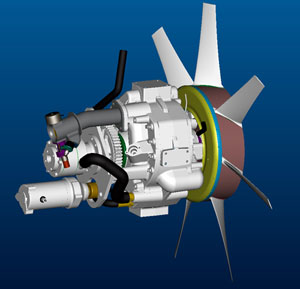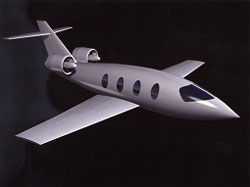Skycar® Technology
Vo - lan - tor (vo-lan'ter) noun: A vertical takeoff and landing aircraft that is capable of flying in a quick, nimble, and agile manner. --intr. & tr.v. -tored, -toring, tors. To go or carry by volantor. [Lat. volare, to fly. Fr. volant, to move in a nimble and agile manner]
The Skycar® is capable of vertical take-off and landing (VTOL) similar to a helicopter and flies from point of departure to destination much like an airplane. However, the Skycar® has been designed to also travel at low speed for short distances on the ground like an automobile. It has fold-up wings which make it narrow enough to be useable on roadways. All this and, incredibly, it's easy to fly!
The on-board flight control systems will manage all aspects of flight, and have final authority over pilot input to prevent pilot error. In manual mode, aircraft is controlled by the pilot providing inputs for direction, speed, and altitude through the cockpit controls. The on-board systems interpret these inputs to control the aircraft; this is also known as "fly-by-wire". Therefore, operating a Skycar® could be piloted by someone with little training or flight experience, however, it may initially require a pilot's license. The Moller Skycar® is a volantor capable of these remarkable capabilities through the use of advanced proprietary technologies developed by Moller International.
Favorable power to weight ratio is the basic qualification for VTOL. However, in order to create a safe, environmentally responsible and economically feasible method of transportation Moller International had to take into consideration a number of components including airframe and engines.
There is a real opportunity to create a unique aircraft centered on the use of nacelles similar to those produced for the Skycar® 400. The low bypass ratio of the small turbofans, for example the PW 600 series exhibits high fuel consumption relative to the thrust produced. Two nacelles drive by Rotapower® engines on the sides of a 4-6 passenger aircraft could provide airspeeds in excess of 300 miles per hour.
Below is a comparison between a Pratt-Whitney PW610F engine and a Skycar® 400 nacelle.
| Skycar® 400 Nacelle | PW 610F | |
| Thrust (max. static) | 900 lbs (300 hp) | 950 lbs |
| Length | 52 inches | 42 inches |
| Diameter | 30 inches (24 inch dia fan) | 14 inches |
| Weight | 250 lbs to 275 lbs | ~300 lbs |
| By-pass Ratio | ~190 | ~3 |
| SFC (static) | .15 lbs per hp-hr | .6 lbs per hp-hr |
The amount of static thrust produced for a given horsepower is roughly a function of the (by-pass ratio) 1/3. Of course there are offsets at speed. The nacelle will have more drag and to avoid variable pitch and reduce internal aerodynamic drag the exit area on the nacelle would need to be reduced at higher speeds. However the direct and indirect costs should be substantially less as well as noise. We have run our engines on diesel fuel but prior to fully developing a "compound" version of the rotary engine (two rotors working in series versus parallel) the limited compression ratio will provide inferior fuel consumption and the need for an ignition source. We have run compound versions of our engine but in a far from optimized form.
Engine Technology

Ducted Fan Configuration


